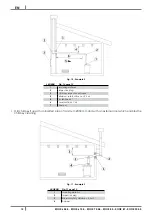
22
KOOK 60 4.0 - KOOK 67 4.0 - KOOK 70 4.0 - KOOK 80 - KOOK 87 - KOOK 90 4.0
EN
Fig. 46 - Tighten the screw with the stop
Fig. 47 - Fasten the stub pipe
•
Fasten the screw and the stops to the exhaust stub pipe (see
).
•
Fasten the screws with the two stops and turn them into the top (see
).
•
Mounting the back exhaust:
Fig. 48 - Cap removal
Fig. 49 - Insert the stub pipe
Fig. 50 - Tighten the screws
•
) and tighten the 4 screws.
•
Fit the stub pipe (see
), tighten the screws with the two stops and turn them (see
With the back exhaust, ignition will be difficult compared to an upper exhaust. We
recommend a round insulated flue with stainless steel sides.
•
The horizontal duct connecting the stub pipe to the flue must be no longer than 30 cm.
12
USE
12.1
INTRODUCTION
To have the best performance with the lowest consumption please follow the here descripted instructions.
•
Wood ignition occurs very easily if the installation is correct and if the chimney flue is efficient.
•
By first ignition of the stove hold a slow fire for at least 4-5 hours in order to allow the material of which
the heater and the hearth are made up of to adjust the inner mechanical stresses. This operation must be
executed at least 3-4 times a year.
•
Plant fat waste and varnishes can release bad smells and smoke during first working hours: it is advisable to
ventilate the room because they can be noxious to people and animals.
•
If inside the combustion chamber there are booklets, manuals, etc..., remove them.
•
Check that the plug is inserted in the power socket (this only applies to forced ventilation stoves).
















































